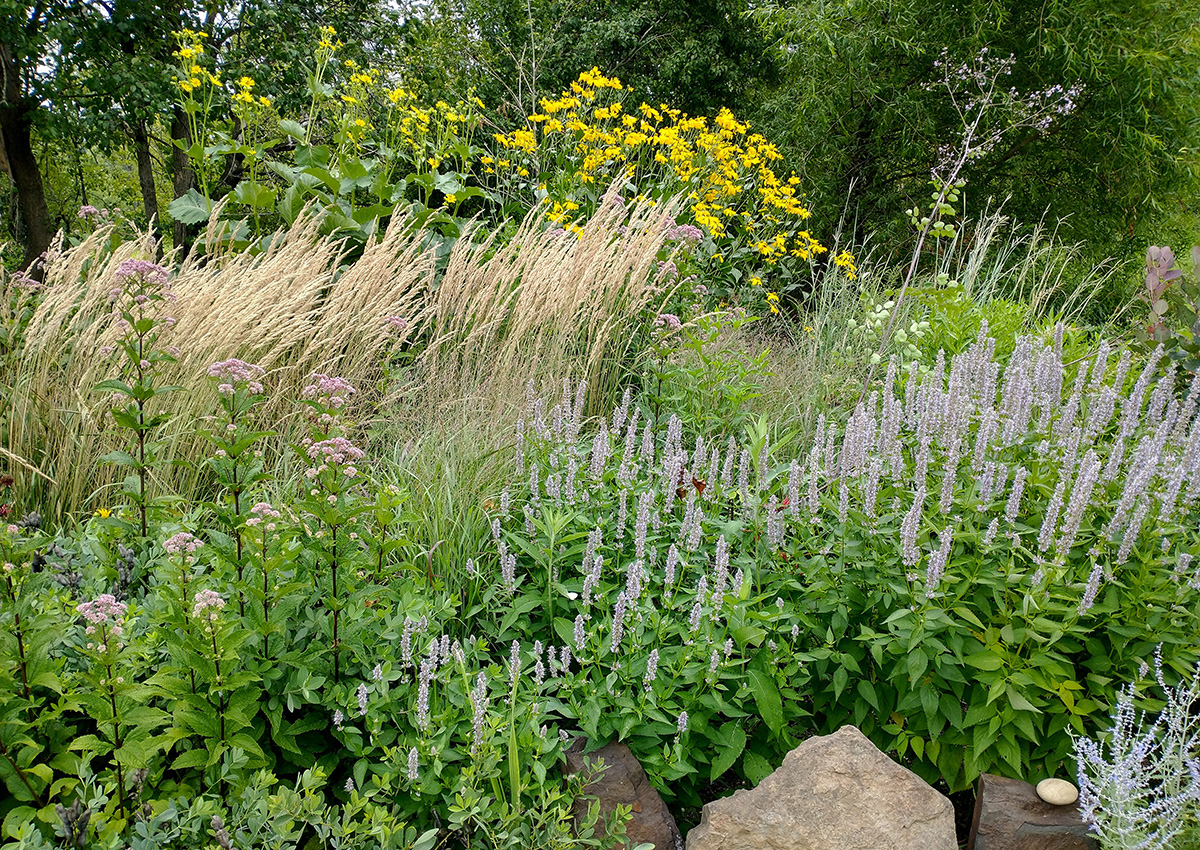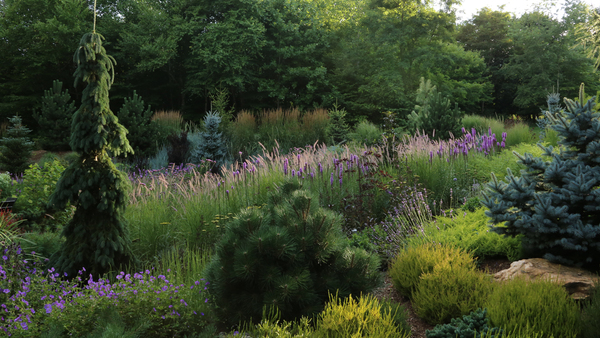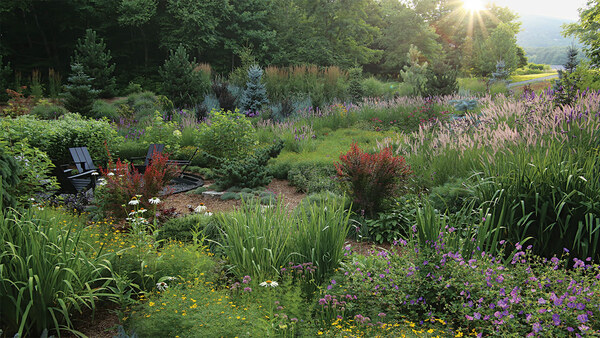
Naturalistic, meadow-styles are visually dynamic, always changing, and have long seasonality. They evoke the feeling of being in nature and spotlight natural cycles of growth to decay. Some public gardens of this style include the Lurie Garden in Chicago, the Meadow Gardens at Delaware Botanic Gardens, and the Oudolf Garden on Detroit’s Belle Isle.
Plants for a meadow garden
Making an engaging naturalistic garden using predominately perennial ornamental grasses and wildflowers requires a degree of artistry. The grasses offer an array of showy inflorescences and leaf blades of various shapes and colors. They animate a meadow planting with movement, sound, and plays of light. Wildflowers are unmatched in their striking forms and intense colors, and many of them have long-lasting ornamental features.
Cool-season ornamental grasses, like ‘Goldtau’ tufted hair grass (Deschampsia cespitosa ‘Goldtau’, Zones 4–9), northern sea oats (Chasmanthium latifolium, Zones 3–8), and blue Lyme grass (Leymus arenarius, Zones 3–10) are great choices to get the show started while warm-season grasses like little bluestem (Schizachyrium scoparium, Zones 3–9) are emerging. Sequencing cool- and warm-season grasses will provide continuous interest into early winter, while shrubs like ‘Mt Aso’ pussy willow (Salix gracilistyla ‘Mt. Aso’, Zones 4–9) and Virginia sweetspire (Itea virginica, Zones 5–9) bring early flower color and interesting foliage to the planting well into fall.
Tips for meadow garden design
If you’d like to create your own meadow-style garden, it’s a good idea to start with some research to deepen your knowledge of your preferred plant palette. Find an open, sunny space, and take some time to consider your design options. As you work out your planting plan, it may be helpful to keep these rules of thumb in mind, inspired by noted meadow-style public gardens:
- Make persistent structure and texture the most important elements in your design.
- Color should be the second-highest priority, with petals and foliage serving as accents or fillers.
- Plant multiples of key cultivars in dense clumps, long bands, and airy drifts.
- Intermingle different plant varieties.
- Add depth and dimension by planting tall to short (i.e., layering)
- Combine cool- and warm-season grasses with wildflowers to provide a sequence of flowering displays throughout the growing season.
A Meadow Garden Through the Seasons

In spring, my meadow garden (pictured above) has the strongest displays of emerging forms, textures, and foliage provided by ornamental grasses, some herbaceous wildflowers, and shrubs that punctuate the meadow with their flowers and leaf colors.

In midsummer, cool-season ornamental grasses show maturing foliage and flower heads, while warm-season grasses start flowering. In the photo above, coastal plain Joe Pye weed (Eupatorium dubium, Zones 4–8), ‘Blue Fortune’ giant hyssop (Agastache ‘Blue Fortune’, Zones 5–9), and cup plant (Silphium perfoliatum, Zones 3–9) bring splashes of color into this section of the garden. Ornamental grasses are starting to mature, with ‘Karl Foerster’ feather reed grass (Calamagrostis acutiflora ‘Karl Foerster’, Zones 5–9) and the flowering of big bluestem (Andropogon gerardii, Zones 4–9) and switchgrass (Panicum virgatum ‘Shenandoah’, Zones 5–9).

Later on in summer, a well-designed meadow-style garden will be bursting with wildflower accents and a confluence of different ornamental grasses. Here, the varied flower forms of sweet coneflower (Rudbeckia subtomentosa, Zones 4–9), rattlesnake master (Eryngium yuccifolium, Zones 3–8), blunt mountain mint (Pycnanthemum muticum, Zones 4–8), and cup plant complement the fine textures of ‘Goldtau’ tufted hair grass, which forms an airy cloud, while warm-season grasses like little bluestem and ‘Morning Light’ miscanthus (Miscanthus sinensis ‘Morning Light’, Zones 6–9) prominently display colorful foliage.

When the first frosts arrive, a phase of plant maturity and decay lends a new sense of gravity to the meadow garden. Even when they are stripped of bold colors, there is still a profound beauty in browned foliage, bare forms, plant skeletons, and seed heads. In the planting above, a palette of browns from the mature forms of little bluestem, Korean feather reed grass (Calamagrostis brachytricha, Zones 4–9), and ‘Karl Foerster’ feather reed grass are enhanced by a play of afternoon sunlight. Soon enough the winter will be over, and the cycle of seasons will begin again in this naturalistic composition.
—Thomas J. Mrazik is a horticulturist and owner of Goodly Gardens in Worcester, Pennsylvania.

















Comments
Log in or create an account to post a comment.
Sign up Log in